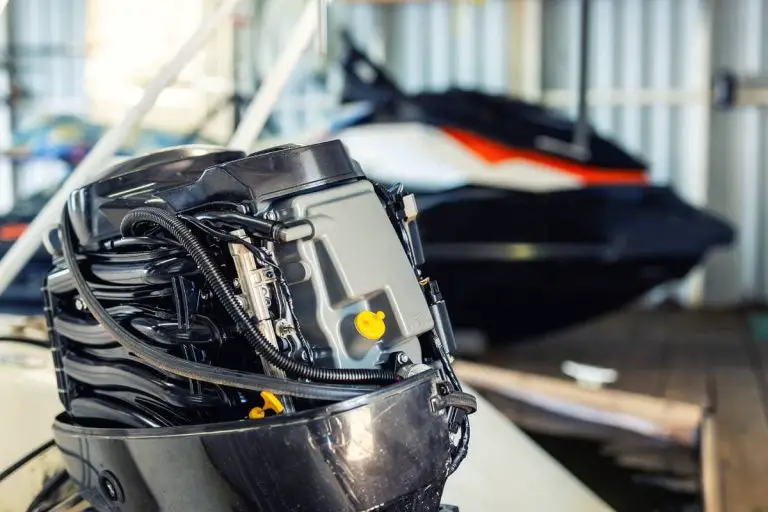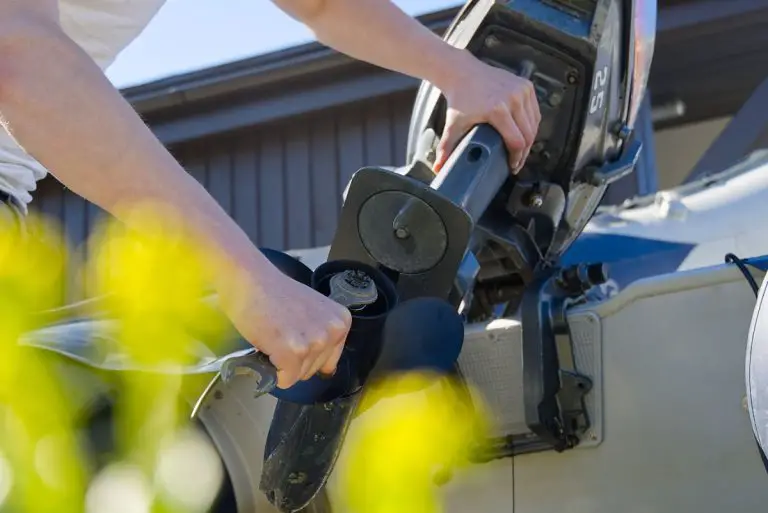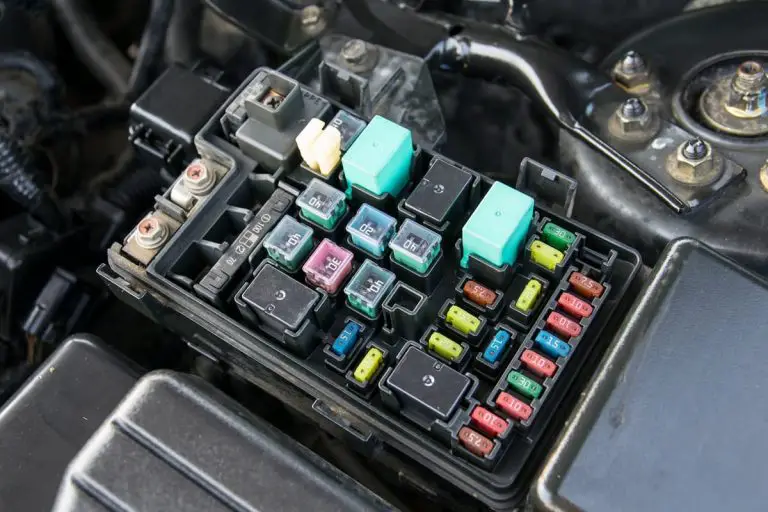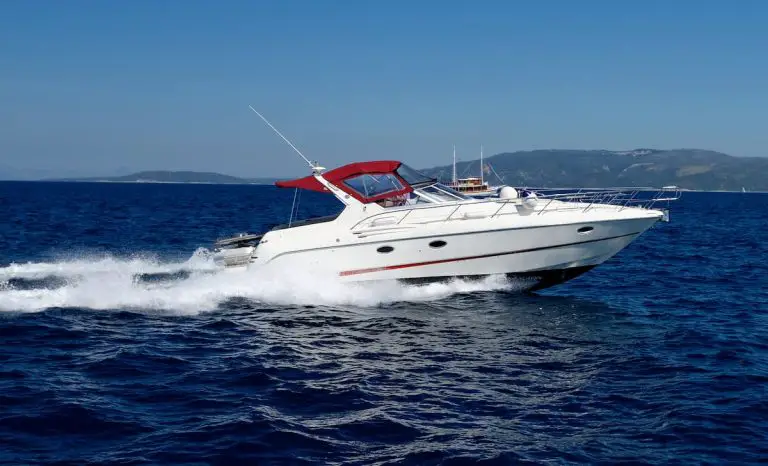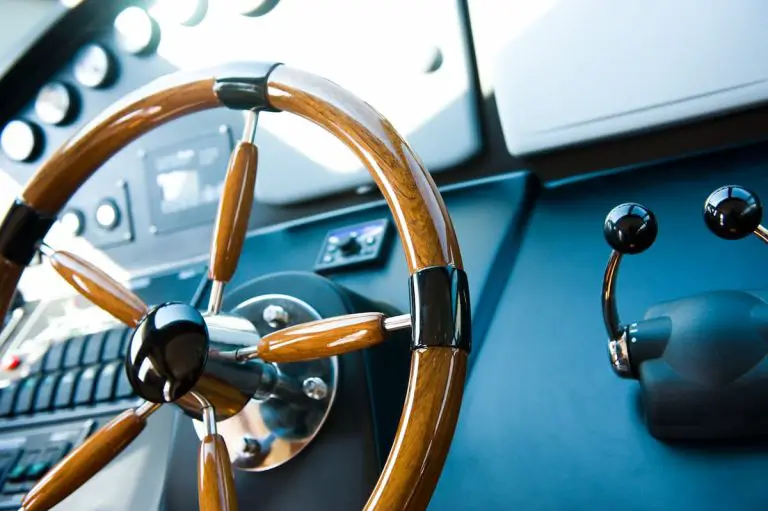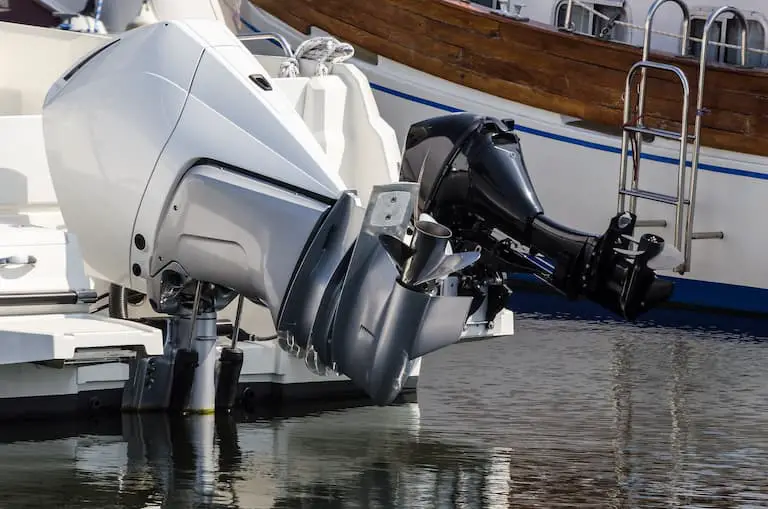12 Reasons a Speed Boat Motor Loses Power
So you’ve blown some coin on a truly awesome speed boat. It’s a ton of fun skimming the waves with a beach-blonde cutie in the passenger seat and all the open water you could want to cruise on. But what if something’s gone wrong with the boat and she doesn’t seem as fast or as powerful as she could be? What causes a speed boat motor to lose power?
Here are the 12 most common causes of a speed boat motor losing power:
- Improper tilt of the outboard motor
- Fuel line damage
- Tank vent is bent
- Clogged fuel filters
- Old or untreated fuel
- Leaking fuel pump
- Old or dirty spark plugs
- Carburetor/fuel injector issues
- Spun propeller
- Compression deprivation
- Dirty Air flow sensor
- Idle air control valve
One by one, we’re going to check out each of these potential problems. We’ll also find out why and how they could deprive your speed boat engine of power. So relax, sit down with a cold beverage, and read on.
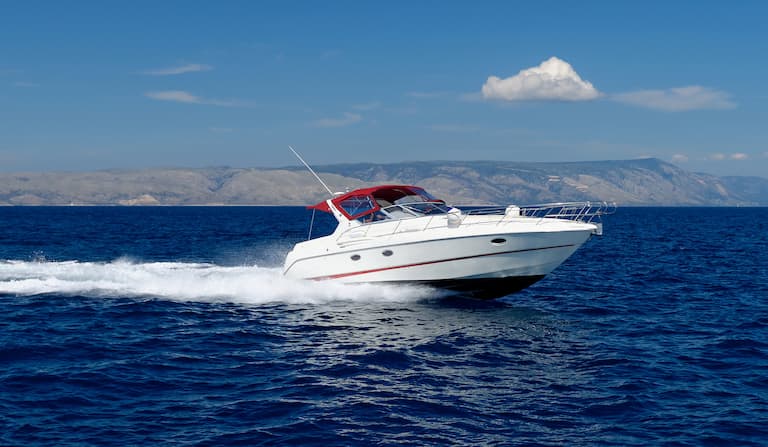
1. Improper Tilt of the Outboard Motor Can Cause Loss of Power
I don’t want you tearing apart your motor just yet. After all, sometimes solutions are so simple that we overlook them in favor of things more complicated. That’s cynicism for you. Let’s not patronize it just yet.
If your speed boat is equipped with an outboard motor, the tilt—or trim—of the propeller plays a crucial role in how much power the boat will be able to use. An easy solution to adjusting the trim is usually located on the dashboard throttle.
With the trim in, the motor tilts away from the transom while the propeller moves closer. Full trim in will allow the boat to receive more power, while with the trim out (the propeller tilted away from the transom), the boat receives less power. With proper trim positioning, your boat will not only gain muscle but will also save fuel.
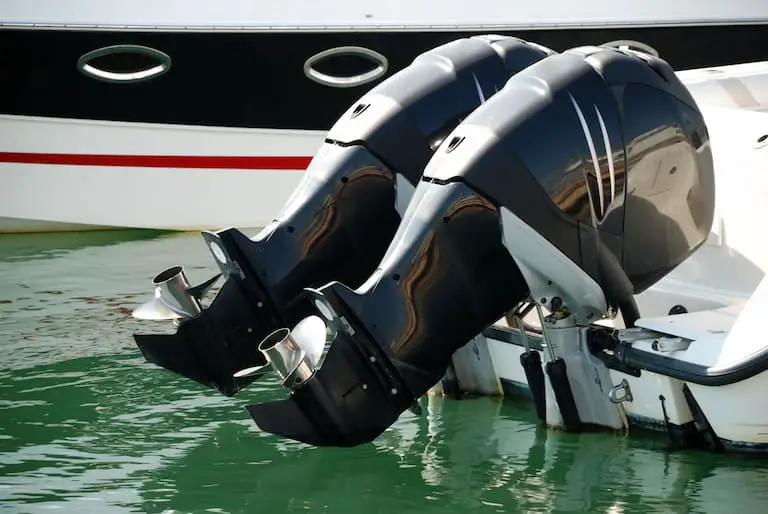
Below is a video that illustrates the fundamentals of trim positioning:
2. Fuel Line Damage Will Cause a Speed Boat to Lose Power
In continuance with checking off the easy things first, we must consider the possibility of fuel line damage. For this step, you only need to follow the line from the speed boat’s fuel tank up to the engine.
Check for nicks, kinks, and leaks. Make sure everything’s tight and in order. As you inspect the line, you will eventually come across two filters, which I will address a little further below.
3. Bent Tank Vent Can Be a Reason For a Boat Engines Power Drop
On a motorcycle, the gas tank breather tube hangs just off the engine, like an afterthought. On speed boats, things are a bit different.
Tank vents exist on a boat’s fuel tank so air can pass through as fuel gets spent (or added). To acknowledge the physics of this, picture a can full of water. To pour the water, you need to break two holes in the top—one for air and the other for liquid.
The same principle applies to your fuel tank. Without the vent, a vacuum occurs that prevents the flow of fuel. These vents are typically located near the fill opening. If your speed boat has been losing power of late, check off another easy box by making sure the tank vent hose isn’t bent or looped to create unwanted vapor-lock.
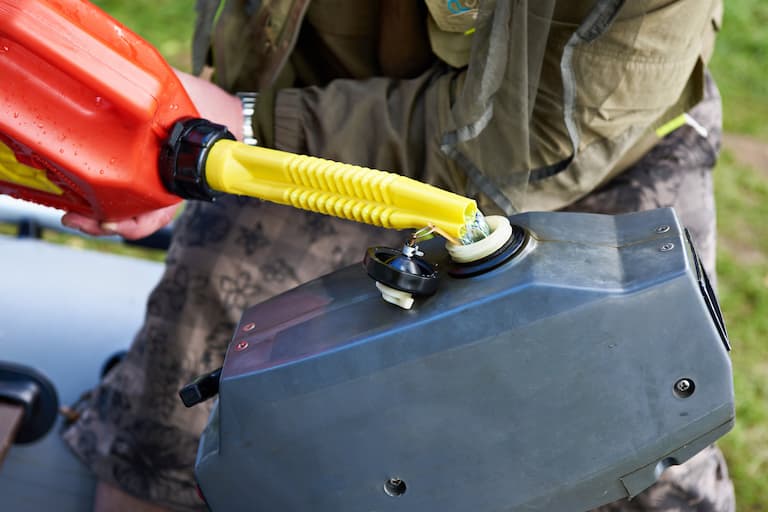
4. Clogged Fuel Filter Will Choke a Boat Motor’s Power
Most speed boat engines carry two fuel filters: a coarse filter for capturing water and a fine filter for capturing smaller debris.
A clogged or damaged fuel filter is a common problem with internal combustion engines. With a bad fuel filter, your craft may cough and sputter intermittently, or just flat out die on the water.
Indeed, many speed boat owners like to carry a spare filter onboard (while oddly, car owners barely think about these things until it’s too late). If you suspect a problem with your fuel filter but don’t have a spare, try cleaning the coarse filter.
Coarse filters typically have a glass bottom that shows how much water it’s blocked from the engine. You should make sure it’s drained before setting out on any maritime adventure.
If the coarse filter already looks clean, then it could be time to address Murphy’s Law and change out the fine filter. This will require a toolbox along with some know-how, but at the end of it all, your boat’s going to run much better.
5. Old or Untreated Fuel Will Reduce Power From a Boat’s Engine
Fuel degradation happens almost as soon as it’s produced. That doesn’t mean the gas in your speed boat is automatically bad. Depending on whether the motor uses petrol or diesel, the elapsed time before the craft begins to lose performance could be weeks or months. To sum up, I present this:
- Untreated petrol degrades after 3-6 months in storage
- Untreated diesel degrades after 6-12 months in storage
A huge catalyst for fuel going bad is water build-up in the tank. That water? It’s going to happen whether you want it or not. Because the temperature outside the tank is almost never the same as it is on the inside, condensation results. And with condensation comes bacteria. And with bacteria comes fuel degradation.
Easiest solution: If you use your boat seasonally and it’s time to bring it out of hibernation, consider changing the fuel. That is if you didn’t already treat the fuel with an over-the-counter product at the end of last season.
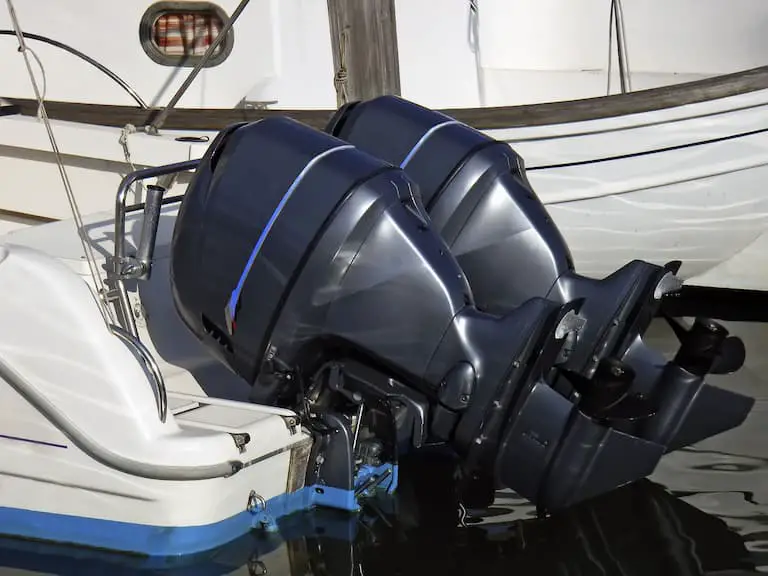
6. Fuel Pump Leaks Will Cause a Speed Boat Motor to Slow Down
Okay, so we’re well into the process of elimination as to why your speed boat is losing power. Check the fuel pump if you know your fuel filters are good but still have an eyebrow raised toward the fuel system.
Like with bad filters, a bad fuel pump may cause your speed boat to sputter and cough on the water. Inspect the hoses it uses for kinks or leaks. If all seems good, make sure the motor doesn’t have a compression problem preventing the fuel pump from doing its job (see compression deprivation in this article below).
Speed boat fuel pumps are not quitters. In other words, they don’t fail often. But if you’ve done troubleshooting on other components of your engine’s fuel intake and still can’t get full power, the pump is probably the culprit.
7. Old or Dirty Spark Plugs Will Cause a Boats Loss of Power
Here we have another issue that is sometimes overlooked for being too obvious. But when it comes to getting optimal performance from your speed boat, spark plugs mean a lot.
When air and fuel get together, they create a high potential for explosion. But like any conjoining of power, they need a spark. This is where the spark plug comes in. Pistons inside your engine block compress air and fuel into a tight space, which is then ignited by the spark plug.
The ignition—or explosion—pushes the pistons back down, spinning the crankshaft so your engine can propel the boat.
A good set of automobile spark plugs can go almost 100,000 miles (160,934.4 km) before replacement becomes necessary. Marine spark plugs are measured by the hour. You should change them after 200 hours of use, even if they look good upon inspection.
Before installing a new set of marine spark plugs, be sure to set the gaps on them correctly. You can find the gap settings for your speed boat’s spark plugs in your owner’s manual.
8. Carburetor/Fuel Injector Issues Will Slow Down a Speed Boat
A quick word on carburetors and fuel injectors before we begin.
- Carburetors: regulate fuel/air flow to the engine using decreased air pressure to induce a vacuum effect.
- Fuel injectors: use a pump to supply fuel electronically, as well as a tiny computer chip that maintains an optimum mixture of air and fuel to the system.
Your speed boat motor will have one or the other. When they become dirty or fail outright, the motor no longer receives the proper amount, or mixture, of air and fuel.
This causes varying degrees of power loss. You could even get stranded on the water. Be sure to keep these components clean and calibrated to keep your speed boat running like a champ.
9. A Spun Propeller Will Limit Boat Speed and Power
Now don’t take this section’s title too literally. Yes, propellers spin. They are supposed to spin. So how can a spun propeller cause your speed boat to lose power? This makes no sense.
In nautical terminology, a spun propeller means that the propeller is not spinning correctly in accordance with the hub. In other words, the hub is spinning like crazy. The propeller, not so much. Your power fall-off will depend on how severe the disconnect is.
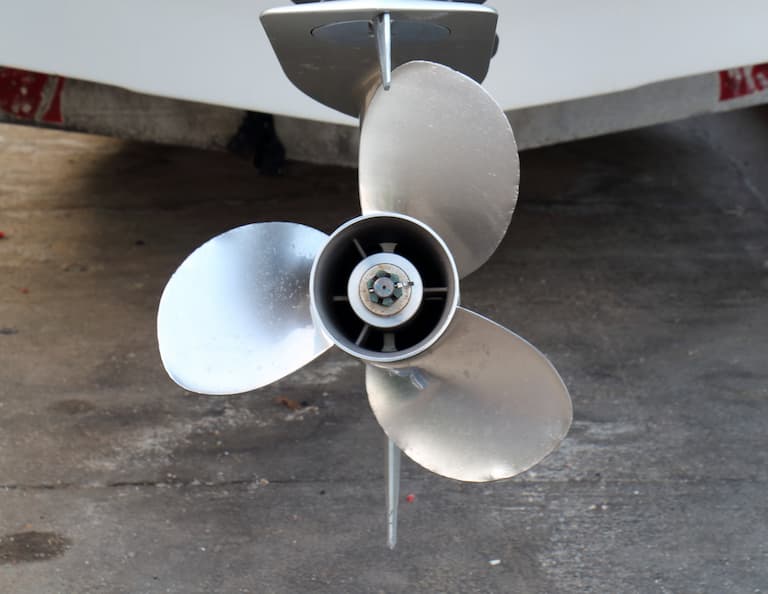
It’s pretty easy to test for a spun prop. Just get the propeller out of the water, make one mark where the prop is attached to the hub, and another directly across on the hub. Now start the motor and run it for a couple of minutes. When you shut the motor off, the marks should still be aligned. If not…spun prop.
At least now you know what the problem is. If you’re confident about fixing it yourself, that’s great. I recommend taking this one to a boat mechanic, though.
10. Compression Deprivation Will Rob a Boat of Speed and Power
Your speed boat’s internal combustion engine needs compression to transfer power. Rotating cylinders create this compression by tightening the mixture of air and fuel as they move. Older engines can lose compression due to basic wear inflicted upon their parts.
Which parts exactly? There’s a lot to unpack here, but I’ll address the most common catalysts.
Bad piston rings are a good place to start.
- Faulty piston rings. Each piston normally sports three rings attached to seal the space between it and the engine wall. A worn piston ring will allow air to escape as the piston rises toward the spark plug, resulting in loss of compression.
- Damaged valve parts will also affect compression. Engine valves control the amount of fuel that enters the combustion chambers. Fuel—and air—can escape the piston chamber when not working correctly. Compression will drop. So will your speed boat’s power.
- A blown head gasket is even more severe than the previous two issues. This gasket rests between the upper and lower part of the boat’s motor, sealing oil off from the air and fuel. If the head gasket fails, you will not only lose compression but also burn oil. Blown head gaskets need to be replaced ASAP; otherwise, the entire engine could be lost.
Other issues can cause compression deprivation, but the above three are the most common. Just pray it’s not the head gasket.
11. Dirty Air Flow Sensor Will Limit a Boat’s Top Speed
If your speed boat motor is fuel-injected, it is likely equipped with a mass air flow sensor. This air flow sensor has a pretty complicated job: It converts air intake into a voltage signal. The signal allows the fuel injector to determine how much air is flowing into the engine, so it can in turn inject the proper amount of fuel.
Dirty air flow sensors can cause speed boat motors to sputter, cough, and hesitate on the water. Luckily, they’re easy to clean (are we going back to easy again?).
You’ll find it somewhere between the air intake and the throttle body. Just pop it out and give it a wash with just about any over-the-counter air flow sensor cleaner.
12. Idle Air Control Valve a Possible Reason For Loss of Power
As a last resort, check the speed boat’s idle air control valve. Or perhaps you should do it first. Permit me to explain.
Last year, my boat was losing power on the waves. Not much, but enough for me to notice from the captain’s chair. I tinkered with all of the above possibilities but still couldn’t get full power restored.
Finally, a friend suggested I check the idle air control valve. This is a gadget located on the throttle body of fuel-injected motors. It regulates the motor’s idle speed, or rotations per minute. It is designed to last for the motor’s lifetime but can sometimes fail, causing intermittent stalling and throttle hesitation.
Replacing the idle air control valve fixed my problem. Was I surprised? You bet. But happy, too.
Summary
No boater is happy when their prized speed boat inexplicably loses power. The twelve possible causes for a speed boat motor to lose power listed in this article will help you troubleshoot the problem.
With a little investigation and some tinkering, there’s a good chance you can restore your speed boat’s power yourself without an expensive repair.
With a little luck, you’ll be flying across the water in your boat in no time!

